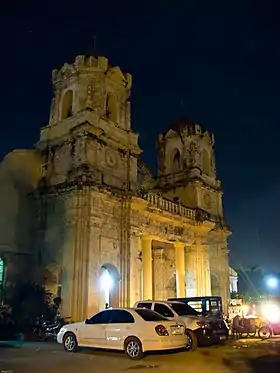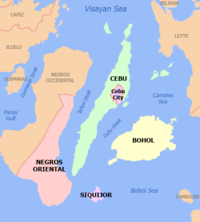Talisay, Cebu
Talisay, officially the City of Talisay (Cebuano: Dakbayan sa Talisay; Tagalog: Lungsod ng Talisay), is a 3rd class component city in the province of Cebu, Philippines. According to the 2015 census, it has a population of 227,645 people. [5]
Talisay | |
|---|---|
| City of Talisay | |
 The Old Talisay Municipal Hall (now the Talisay City College, TCC) | |
 Seal | |
| Nickname(s): | |
 Map of Cebu with Talisay highlighted | |
OpenStreetMap 
| |
.svg.png.webp) Talisay Location within the Philippines | |
| Coordinates: 10°15′N 123°50′E | |
| Country | |
| Region | Central Visayas (Region VII) |
| Province | Cebu |
| District | 1st District |
| Founded | 1648 |
| Municipality (Year) | 1849 |
| Cityhood | January 12, 2001 |
| Barangays | 22 (see Barangays) |
| Government | |
| • Type | Sangguniang Panlungsod |
| • Mayor | Gerald Anthony V. Gullas Jr. |
| • Vice Mayor | Alan G. Bucao |
| • Representative | Eduardo R. Gullas |
| • Electorate | 138,606 voters (2019) |
| Area | |
| • Total | 39.87 km2 (15.39 sq mi) |
| Elevation | 108 m (354 ft) |
| Population | |
| • Total | 227,645 |
| • Density | 5,700/km2 (15,000/sq mi) |
| • Households | 49,871 |
| Economy | |
| • Income class | 3rd city income class |
| • Poverty incidence | 14.07% (2015)[6] |
| • Revenue | ₱566,367,767.90 (2016) |
| Time zone | UTC+8 (PST) |
| ZIP code | 6045 |
| PSGC | |
| IDD : area code | +63 (0)32 |
| Climate type | tropical monsoon climate |
| Native languages | Cebuano Tagalog |
| Major religions | Roman Catholicism |
| Feast Day | October 15 |
| Patron saint | Saint Teresa of Avila |
Primarily a residential and trading center, Talisay lies within the Metro Cebu area. It is bordered to the north by Cebu City, to the west is the city of Toledo, to the east is the Cebu Strait, and to the south is the town of Minglanilla.
The name of Talisay is taken from the magtalisay tree which is abundant in the city.
History
Talisay was founded in 1648 as an estate owned by the Augustinians. In 1849 it was converted into a municipality.
During both the American colonial period and World War II, Talisay served as a haven of colonial military forces. The municipality served as the center of guerrilla intelligence operations for the Philippine resistance movement in Cebu during World War II. The returning U. S. liberation forces landed on the beaches of Talisay on 28 March 1945, and were helped together with the Philippine Commonwealth forces and the Cebuano guerrillas, an event that marked the eventual surrender of Japanese forces on Cebu. That day is now an official holiday in the province of Cebu.
In 2000 the municipality of Talisay was converted into a city through Republic Act No. 8979.[7] The municipality is now linked to Cebu City via the South Coastal Highway from Lawaan, opened in 2004. This brought some recent inward investment in the form of subdivisions, but some hastily planned plagued by problems. Conflict occurred between the residents of the mountain barangay of Maghaway and those of Crown Asia's Azienda Milan and Venezia subdivisions.
Barangays
Talisay City comprises 22 barangays:
| PSGC | Barangay | Population | ±% p.a. | |||
|---|---|---|---|---|---|---|
| 2015 [5] | 2010 [8] | |||||
| 072250019 | Biasong | 2.8% | 6,482 | 5,542 | 3.03% | |
| 072250001 | Bulacao | 5.6% | 12,697 | 11,579 | 1.77% | |
| 072250002 | Cadulawan | 1.9% | 4,379 | 3,812 | 2.68% | |
| 072250020 | Camp IV | 1.5% | 3,305 | 2,258 | 7.52% | |
| 072250003 | Cansojong | 7.0% | 16,016 | 12,645 | 4.60% | |
| 072250004 | Dumlog | 7.8% | 17,785 | 12,709 | 6.61% | |
| 072250005 | Jaclupan | 3.8% | 8,684 | 7,891 | 1.84% | |
| 072250006 | Lagtang | 6.1% | 13,830 | 10,394 | 5.59% | |
| 072250007 | Lawaan I | 4.1% | 9,413 | 9,503 | −0.18% | |
| 072250021 | Lawaan II | 2.7% | 6,033 | 5,625 | 1.34% | |
| 072250022 | Lawaan III | 5.3% | 12,037 | 10,708 | 2.25% | |
| 072250008 | Linao | 4.4% | 10,110 | 7,951 | 4.68% | |
| 072250009 | Maghaway | 3.1% | 7,148 | 6,869 | 0.76% | |
| 072250010 | Manipis | 1.1% | 2,456 | 1,994 | 4.05% | |
| 072250011 | Mohon | 4.7% | 10,735 | 9,582 | 2.19% | |
| 072250012 | Poblacion | 5.6% | 12,756 | 12,107 | 1.00% | |
| 072250013 | Pooc | 5.1% | 11,699 | 8,912 | 5.32% | |
| 072250014 | San Isidro | 6.0% | 13,753 | 12,502 | 1.83% | |
| 072250015 | San Roque | 8.0% | 18,161 | 16,950 | 1.32% | |
| 072250016 | Tabunok | 6.4% | 14,682 | 17,593 | −3.39% | |
| 072250017 | Tangke | 6.0% | 13,707 | 11,891 | 2.74% | |
| 072250018 | Tapul | 0.8% | 1,777 | 1,755 | 0.24% | |
| Total | 227,645 | 200,772 | 2.42% | |||
Climate
| Climate data for Talisay City, Cebu | |||||||||||||
|---|---|---|---|---|---|---|---|---|---|---|---|---|---|
| Month | Jan | Feb | Mar | Apr | May | Jun | Jul | Aug | Sep | Oct | Nov | Dec | Year |
| Average high °C (°F) | 28 (82) |
29 (84) |
30 (86) |
31 (88) |
31 (88) |
30 (86) |
30 (86) |
30 (86) |
30 (86) |
29 (84) |
29 (84) |
28 (82) |
30 (85) |
| Average low °C (°F) | 23 (73) |
23 (73) |
23 (73) |
24 (75) |
25 (77) |
25 (77) |
25 (77) |
25 (77) |
25 (77) |
25 (77) |
24 (75) |
23 (73) |
24 (75) |
| Average precipitation mm (inches) | 70 (2.8) |
49 (1.9) |
62 (2.4) |
78 (3.1) |
138 (5.4) |
201 (7.9) |
192 (7.6) |
185 (7.3) |
192 (7.6) |
205 (8.1) |
156 (6.1) |
111 (4.4) |
1,639 (64.6) |
| Average rainy days | 13.4 | 10.6 | 13.1 | 14.5 | 24.2 | 27.9 | 28.4 | 27.7 | 27.1 | 27.4 | 22.5 | 15.9 | 252.7 |
| Source: Meteoblue [9] | |||||||||||||
Demographics
|
| ||||||||||||||||||||||||||||||||||||||||||||||||
| Source: Philippine Statistics Authority [5] [8] [10] | |||||||||||||||||||||||||||||||||||||||||||||||||
In 2017, Talisay City was the most densely populated city in the Cebu province. This ranking does not include highly urbanized cities: Cebu City, Lapu-Lapu, & Mandaue. There were 5,710 people living per square kilometer.
Cebuano is the predominant language of the inhabitants of the city (96%).
Religion

Talisay City has a Roman Catholic-majority population. It also has sizeable Protestant and non-Christian minorities.
Economy
Talisay remains an important center for the production of blasting caps used in dynamite.
Much of the commerce in Talisay takes place in the Tabunok area, where several public markets, strip malls and commercial establishments are situated. The biggest mall is Gaisano Grand Fiesta Mall Tabunok, which has a supermarket, department store and formerly, a cinema. However, much of the population still depend on the public markets, where they can find fresh meat, fish and vegetables, as well as other household needs. There are many sari-sari stores. Talisay City and the Tabunok area also serve as the commercial area for municipalities south of the city, being the southern gateway to Cebu City.
Transport
Talisay City, its citizens and its surrounding barangays have benefited from the construction of the South Road Properties project, which is a 6-lane coastal highway from downtown Cebu City to the town of Minglanilla, with several exits in between, many of which serve several areas of Talisay. Because of this highway, traffic, which has always been a problem for the inhabitants in the past few years for this area, has been greatly reduced, making the city a popular zone for housing once more, as it was in the early 70s and 80s.
In 2016 Talisay City Council expressed support for the proposed Light Rail Transit (LRT) project in Cebu.[11]
Culture
Talisay City is considered as the "Lechon Capital of Cebu" and is considered as one of the two places to get the best of the best Lechon in Cebu, with the other place being Carcar City. Their roasted pig, which is nicknamed "Inasal", has put the town on the map. Because of their Lechon, the town decided to create a religious-cultural endeavor to promote Talisay City, which was "Halad Inasal Festival". The festival is in honor of St. Teresa of Avila, Talisay City's patron saint, and is highlighted by street dancing merged with a procession with roasted pig, which then culminates with a ritual showdown and a grand finale with a firework display.
Education
- 20 Elementary schools (Private & Public)
- 12 Public secondary schools
- 8 Private secondary schools
- 3 Colleges
- 5 Kindergartens
- 5 Seminaries
References
- https://web.archive.org/web/20060616012607/http://www.talisaycitycebu.gov.ph/index.htm
- http://www.coa.gov.ph › Cebu › TalisayCity_Cebu_ES2016
- City of Talisay | (DILG)
- "Province: Cebu". PSGC Interactive. Quezon City, Philippines: Philippine Statistics Authority. Retrieved 12 November 2016.
- Census of Population (2015). "Region VII (Central Visayas)". Total Population by Province, City, Municipality and Barangay. PSA. Retrieved 20 June 2016.
- "PSA releases the 2015 Municipal and City Level Poverty Estimates". Quezon City, Philippines. Retrieved 12 October 2019.
- NSCB - 2001 Factsheet - 12 New Cities Created, July–December 2000.
- Census of Population and Housing (2010). "Region VII (Central Visayas)". Total Population by Province, City, Municipality and Barangay. NSO. Retrieved 29 June 2016.
- "Talisay: Average Temperatures and Rainfall". Meteoblue. Retrieved 10 May 2020.
- Censuses of Population (1903–2007). "Region VII (Central Visayas)". Table 1. Population Enumerated in Various Censuses by Province/Highly Urbanized City: 1903 to 2007. NSO.
- Sun Star Cebu 2016.
Sources
- Gonzales, Glenda R. (December 2004). "Metro Cebu: A Metropolitan Area in Need of Coordinative Body" (PDF). Discussion Paper. 2004-49. Philippine Institute for Development Studies. Retrieved 16 February 2016.
- Sun Star Cebu, Justin K. Vestil (5 August 2016). "LRT system gets backing of Talisay council". Archived from the original on 6 August 2016.
External links
| Wikimedia Commons has media related to Talisay. |
